oil temperature RENAULT TWINGO RS 2009 2.G Electrical Equipment - Petrol Injection Workshop Manual
[x] Cancel search | Manufacturer: RENAULT, Model Year: 2009, Model line: TWINGO RS, Model: RENAULT TWINGO RS 2009 2.GPages: 348
Page 10 of 348
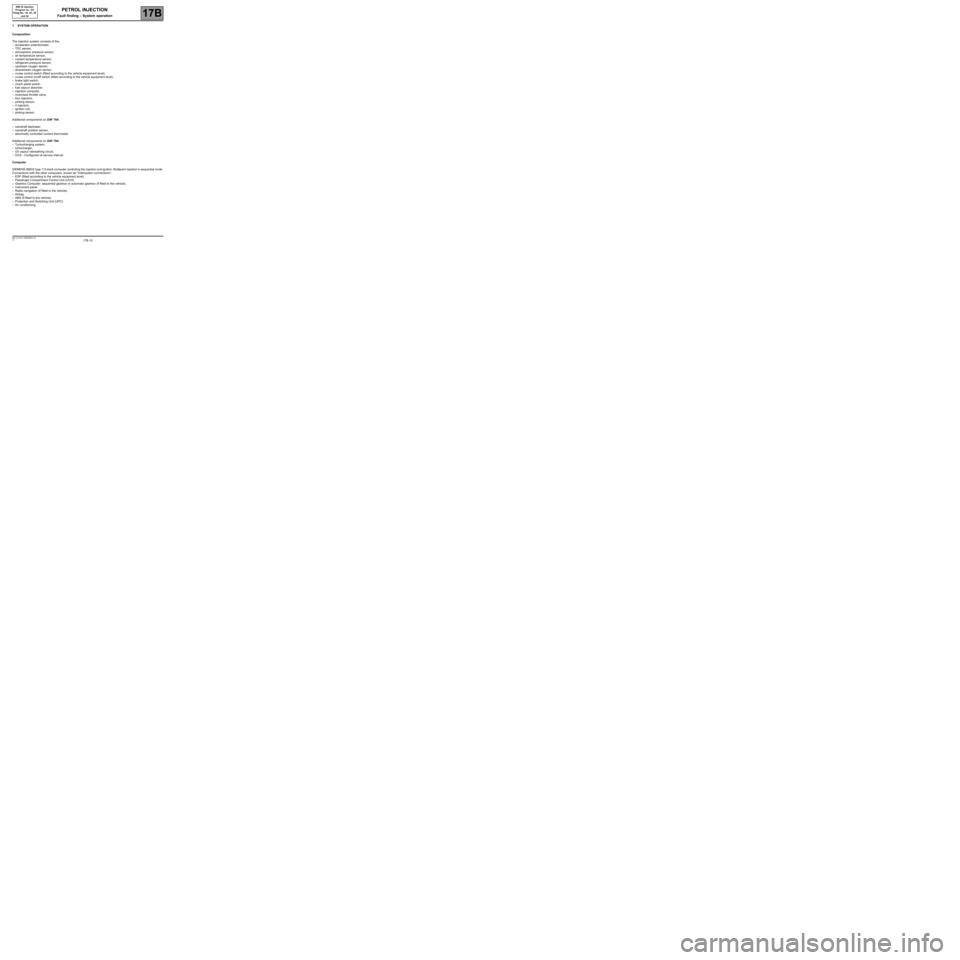
17B-10V7 MR-413-X44-17B000$030.mif
17B
SIM 32 Injection
Program no.: D3
Vdiag No.: 44, 4C, 50
and 54
1. SYSTEM OPERATION
Composition
The injection system consists of the:
–accelerator potentiometer,
–TDC sensor,
–atmospheric pressure sensor,
–air temperature sensor,
–coolant temperature sensor,
–refrigerant pressure sensor,
–upstream oxygen sensor,
–downstream oxygen sensor,
–cruise control switch (fitted according to the vehicle equipment level),
–cruise control on/off switch (fitted according to the vehicle equipment level),
–brake light switch,
–clutch pedal switch,
–fuel vapour absorber,
–injection computer,
–motorised throttle valve,
–four injectors,
–pinking sensor,
–4 injectors,
–ignition coil,
–pinking sensor.
Additional components on D4F 764:
–camshaft dephaser,
–camshaft position sensor,
–electrically controlled coolant thermostat.
Additional components on D4F 784:
–Turbocharging system,
–turbocharger,
–Oil vapour rebreathing circuit,
–OCS - Configured oil service interval.
Computer
SIEMENSSIM32type112-track co mputer controlling the injection a nd ignition. M ultipoint injection in se quential mode.
Connections with the other computers, known as "Intersystem connections":
–ESP (fitted according to the vehicle equipment level).
–Passenger Compartment Control Unit (UCH).
–Gearbox Computer: sequential gearbox or automatic gearbox (if fitted to the vehicle).
–Instrument panel.
–Radio navigation (if fitted to the vehicle).
–Airbag.
–ABS (if fitted to the vehicle).
–Protection and Switching Unit (UPC).
–Air conditioning.
PETROL INJECTION
Fault finding – System operation
Page 13 of 348
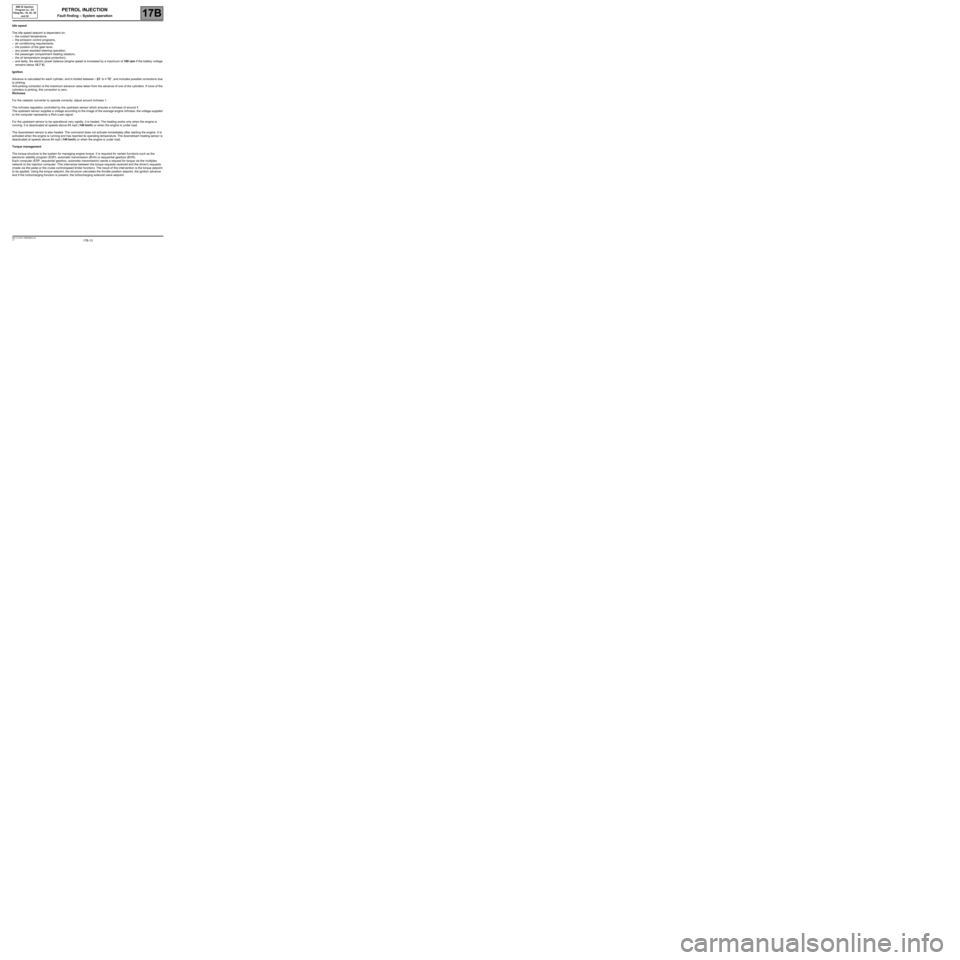
17B-13V7 MR-413-X44-17B000$030.mif
PETROL INJECTION
Fault finding – System operation17B
SIM 32 Injection
Program no.: D3
Vdiag No.: 44, 4C, 50
and 54
Idle speed
The idle speed setpoint is dependent on:
–the coolant temperature,
–the emission control programs,
–air conditioning requirements,
–the position of the gear lever,
–any power-assisted steering operation,
–the passenger compartment heating resistors,
–the oil temperature (engine protection),
–and lastly, the electric power balance (engine speed is increased by a maximum of 160 rpm if the battery voltage
remains below 12.7 V).
Ignition
Advance is calculated for each cylinder, and is limited between - 23˚ to + 72˚, and includes possible corrections due
to pinking.
Anti-pinking correction is the maximum advance value taken from the advance of one of the cylinders. If none of the
cylinders is pinking, this correction is zero.
Richness
For the catalytic converter to operate correctly, adjust around richness 1.
The richness regulation controlled by the upstream sensor which ensures a richness of around 1.
The upstream sensor supplies a voltage according to the image of the average engine richness: the voltage supplied
to the computer represents a Rich-Lean signal.
For the upstream sensor to be operational very rapidly, it is heated. The heating works only when the engine is
running. It is deactivated at speeds above 84 mph (140 km/h) or when the engine is under load.
The downstream sensor is also heated. The command does not activate immediately after starting the engine. It is
activated when the engine is running and has reached its operating temperature. The downstream heating sensor is
deactivated at speeds above 84 mph (140 km/h) or when the engine is under load.
Torque management
The torque structure is the system for managing engine torque. It is required for certain functions such as the
electronic stability program (ESP), automatic transmission (BVA) or sequential gearbox (BVR).
Each computer (ESP, sequential gearbox, automatic transmission) sends a request for torque via the multiplex
network to the injection computer. This intervenes between the torque requests received and the driver's requests
(made via the pedal or the cruise control/speed limiter function). The result of this intervention is the torque setpoint
to be applied. Using the torque setpoint, the structure calculates the throttle position setpoint, the ignition advance
and if the turbocharging function is present, the turbocharging solenoid valve setpoint.
Page 19 of 348
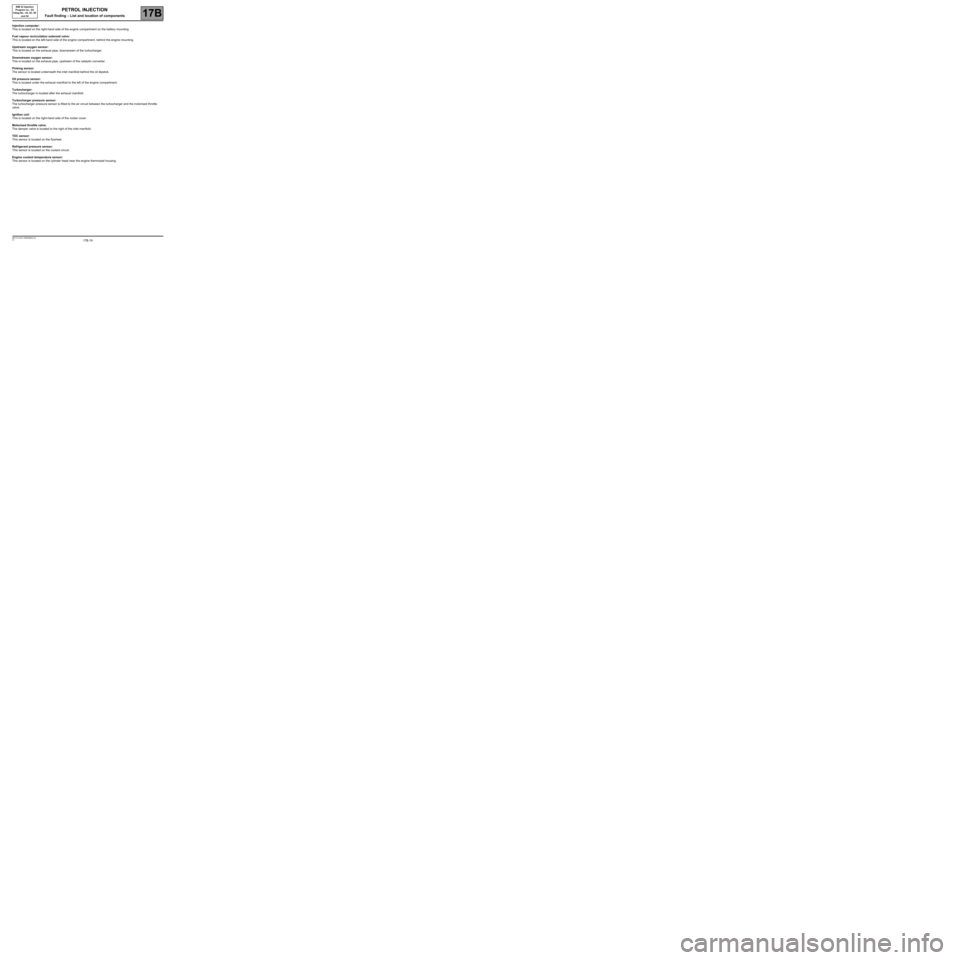
17B-19V7 MR-413-X44-17B000$040.mif
17B
SIM 32 Injection
Program no.: D3
Vdiag No.: 44, 4C, 50
and 54
Injection computer:
This is located on the right-hand side of the engine compartment on the battery mounting.
Fuel vapour recirculation solenoid valve:
This is located on the left-hand side of the engine compartment, behind the engine mounting.
Upstream oxygen sensor:
This is located on the exhaust pipe, downstream of the turbocharger.
Downstream oxygen sensor:
This is located on the exhaust pipe, upstream of the catalytic converter.
Pinking sensor:
The sensor is located underneath the inlet manifold behind the oil dipstick.
Oil pressure sensor:
This is located under the exhaust manifold to the left of the engine compartment.
Turbocharger:
The turbocharger is located after the exhaust manifold.
Turbocharger pressure sensor:
The turbocharger pressure sensor is fitted to the air circuit between the turbocharger and the motorised throttle
valve.
Ignition coil:
This is located on the right-hand side of the rocker cover.
Motorised throttle valve:
The damper valve is located to the right of the inlet manifold.
TDC sensor:
This sensor is located on the flywheel.
Refrigerant pressure sensor:
This sensor is located on the coolant circuit.
Engine coolant temperature sensor:
This sensor is located on the cylinder head near the engine thermostat housing.
PETROL INJECTION
Fault finding – List and location of components
Page 22 of 348
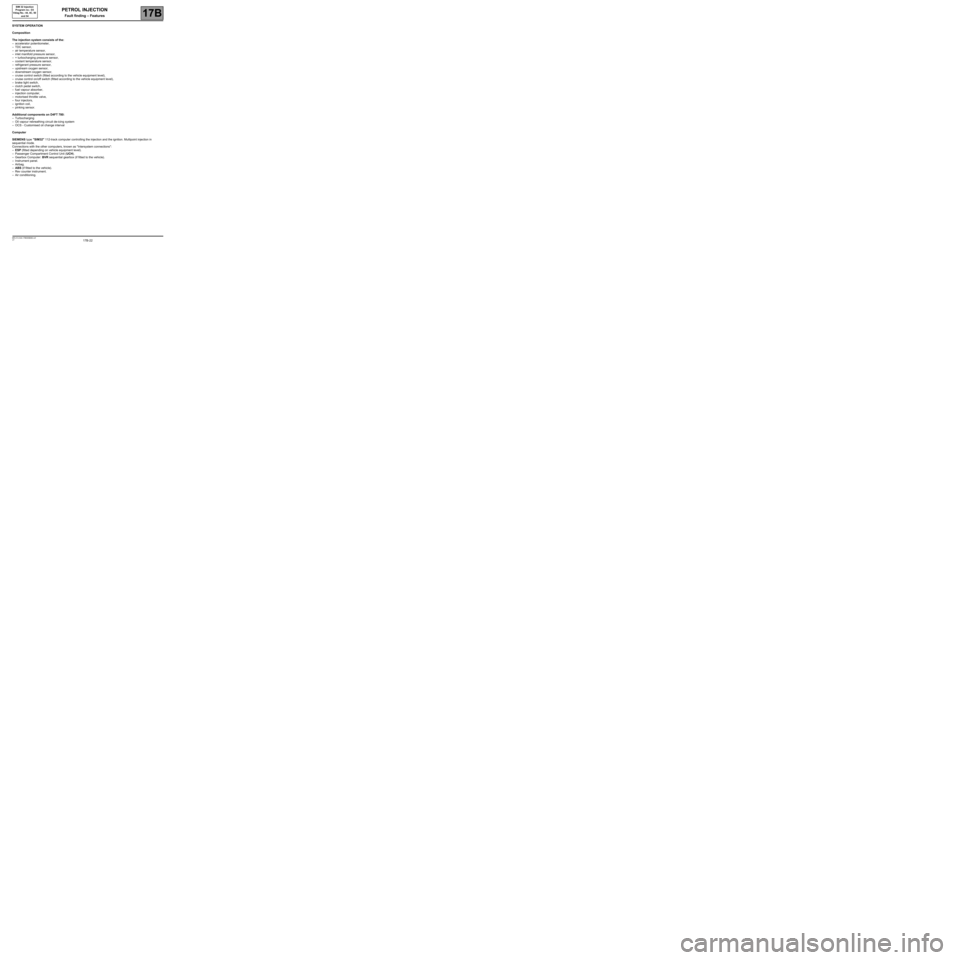
17B-22V7 MR-413-X44-17B000$060.mif
17B
SIM 32 Injection
Program no.: D3
Vdiag No.: 44, 4C, 50
and 54
SYSTEM OPERATION
Composition
The injection system consists of the:
–accelerator potentiometer,
–TDC sensor,
–air temperature sensor,
–inlet manifold pressure sensor,
–+ turbocharging pressure sensor,
–coolant temperature sensor,
–refrigerant pressure sensor,
–upstream oxygen sensor,
–downstream oxygen sensor,
–cruise control switch (fitted according to the vehicle equipment level),
–cruise control on/off switch (fitted according to the vehicle equipment level),
–brake light switch,
–clutch pedal switch,
–fuel vapour absorber,
–injection computer,
–motorised throttle valve,
–four injectors,
–ignition coil,
–pinking sensor.
Additional components on D4FT 780:
–Turbocharging
–Oil vapour rebreathing circuit de-icing system
–OCS - Customised oil change interval
Computer
SIEMENS type "SIM32" 112-track computer controlling the injection and the ignition. Multipoint injection in
sequential mode.
Connections with the other computers, known as "Intersystem connections":
–ESP (fitted depending on vehicle equipment level).
–Passenger Compartment Control Unit (UCH).
–Gearbox Computer: BVR sequential gearbox (if fitted to the vehicle).
–Instrument panel.
–Airbag.
–ABS (if fitted to the vehicle).
–Rev counter instrument.
–Air conditioning.
PETROL INJECTION
Fault finding – Features
Page 24 of 348
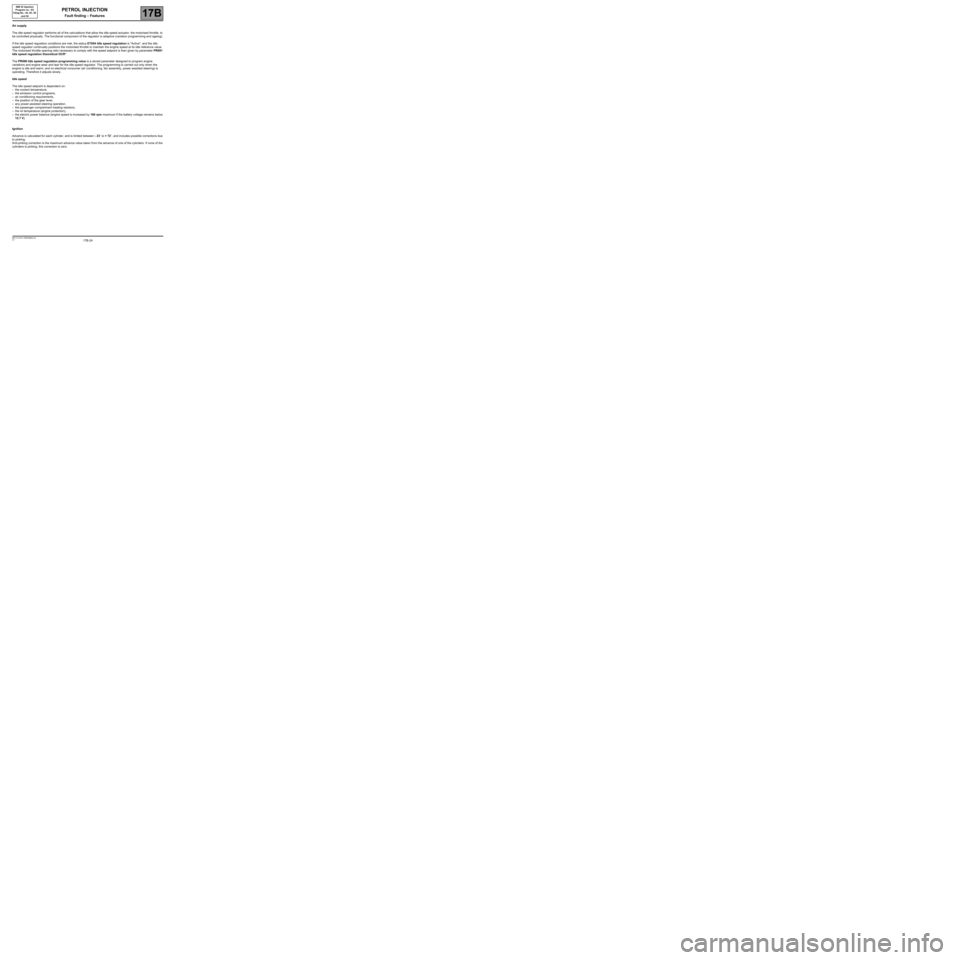
17B-24V7 MR-413-X44-17B000$060.mif
PETROL INJECTION
Fault finding – Features17B
SIM 32 Injection
Program no.: D3
Vdiag No.: 44, 4C, 50
and 54
Air supply
The idle speed regulator performs all of the calculations that allow the idle speed actuator, the motorised throttle, to
be controlled physically. The functional component of the regulator is adaptive (variation programming and ageing).
If the idle speed regulation conditions are met, the status ET054 Idle speed regulation is "Active", and the idle
speed regulator continually positions the motorised throttle to maintain the engine speed at its idle reference value.
The motorised throttle opening ratio necessary to comply with the speed setpoint is then given by parameter PR091
Idle speed regulation theoretical OCR*.
The PR090 Idle speed regulation programming value is a stored parameter designed to program engine
variations and engine wear and tear for the idle speed regulator. The programming is carried out only when the
engine is idle and warm, and no electrical consumer (air conditioning, fan assembly, power assisted steering) is
operating. Therefore it adjusts slowly.
Idle speed
The idle speed setpoint is dependent on:
–the coolant temperature,
–the emission control programs,
–air conditioning requirements,
–the position of the gear lever,
–any power-assisted steering operation,
–the passenger compartment heating resistors,
–the oil temperature (engine protection),
–the electric power balance (engine speed is increased by 160 rpm maximum if the battery voltage remains below
12.7 V).
Ignition
Advance is calculated for each cylinder, and is limited between - 23˚ to + 72˚, and includes possible corrections due
to pinking.
Anti-pinking correction is the maximum advance value taken from the advance of one of the cylinders. If none of the
cylinders is pinking, this correction is zero.
Page 26 of 348
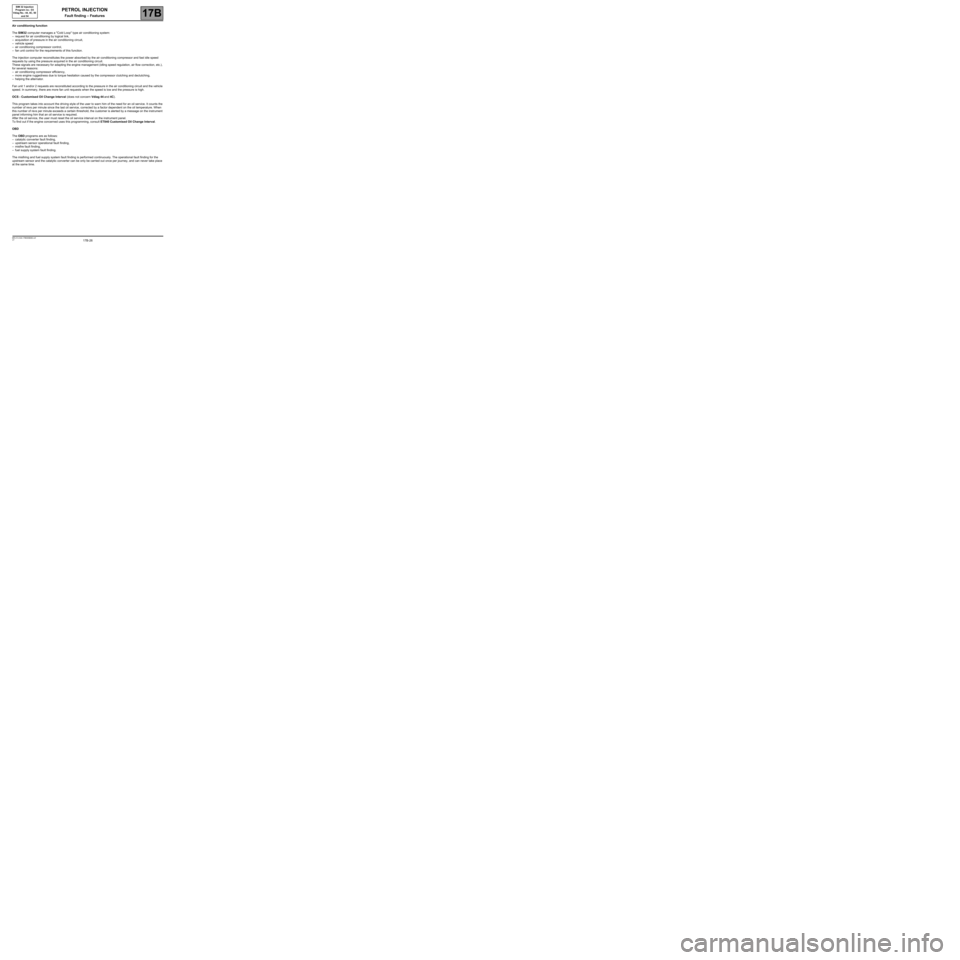
17B-26V7 MR-413-X44-17B000$060.mif
PETROL INJECTION
Fault finding – Features17B
SIM 32 Injection
Program no.: D3
Vdiag No.: 44, 4C, 50
and 54
Air conditioning function
The SIM32 computer manages a "Cold Loop" type air conditioning system:
–request for air conditioning by logical link,
–acquisition of pressure in the air conditioning circuit,
–vehicle speed
–air conditioning compressor control,
–fan unit control for the requirements of this function.
The injection computer reconstitutes the power absorbed by the air conditioning compressor and fast idle speed
requests by using the pressure acquired in the air conditioning circuit.
These signals are necessary for adapting the engine management (idling speed regulation, air flow correction, etc.),
for several reasons:
–air conditioning compressor efficiency,
–more engine ruggedness due to torque hesitation caused by the compressor clutching and declutching,
–helping the alternator.
Fan unit 1 and/or 2 requests are reconstituted according to the pressure in the air conditioning circuit and the vehicle
speed. In summary, there are more fan unit requests when the speed is low and the pressure is high.
OCS - Customised Oil Change Interval (does not concern Vdiag 44 and 4C).
This program takes into account the driving style of the user to warn him of the need for an oil service. It counts the
number of revs per minute since the last oil service, corrected by a factor dependent on the oil temperature. When
this number of revs per minute exceeds a certain threshold, the customer is alerted by a message on the instrument
panel informing him that an oil service is required.
After the oil service, the user must reset the oil service interval on the instrument panel.
To find out if the engine concerned uses this programming, consult ET840 Customised Oil Change Interval.
OBD
The OBD programs are as follows:
–catalytic converter fault finding,
–upstream sensor operational fault finding,
–misfire fault finding,
–fuel supply system fault finding.
The misfiring and fuel supply system fault finding is performed continuously. The operational fault finding for the
upstream sensor and the catalytic converter can be only be carried out once per journey, and can never take place
at the same time.
Page 31 of 348
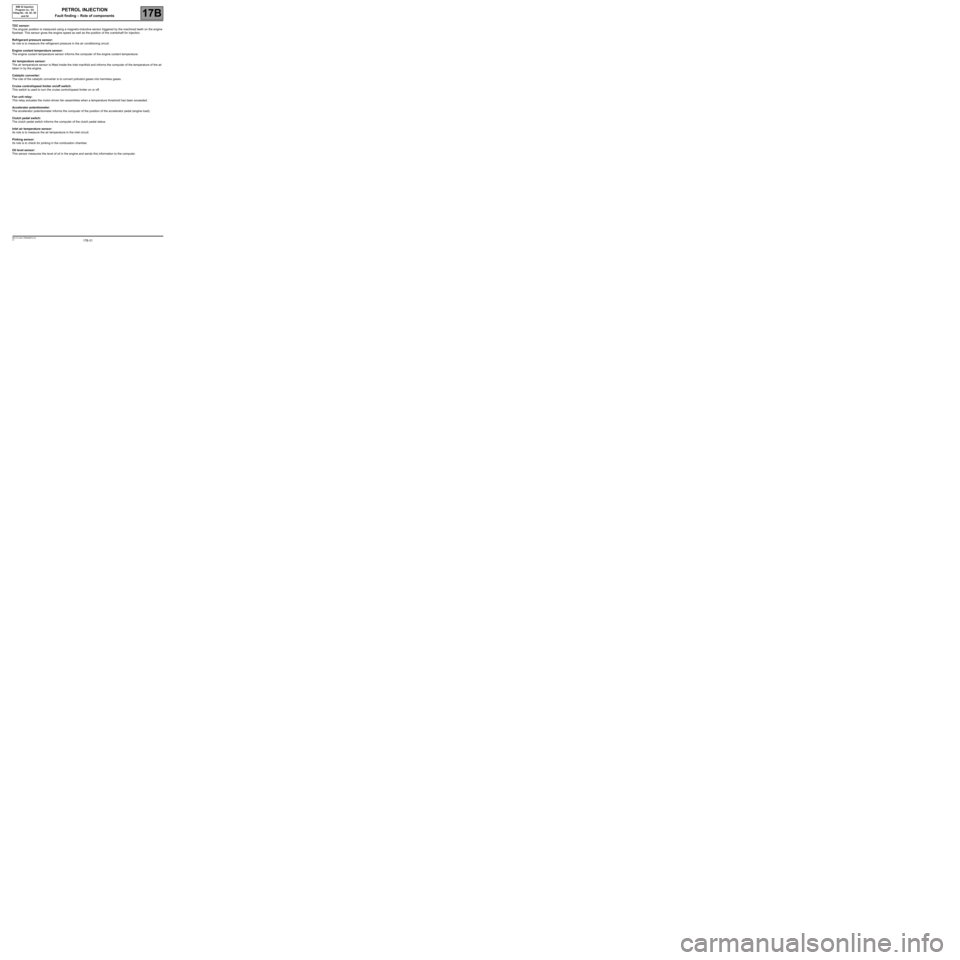
17B-31V7 MR-413-X44-17B000$070.mif
PETROL INJECTION
Fault finding – Role of components17B
SIM 32 Injection
Program no.: D3
Vdiag No.: 44, 4C, 50
and 54
TDC sensor:
The angular position is measured using a magneto-inductive sensor triggered by the machined teeth on the engine
flywheel. This sensor gives the engine speed as well as the position of the crankshaft for injection.
Refrigerant pressure sensor:
Its role is to measure the refrigerant pressure in the air conditioning circuit.
Engine coolant temperature sensor:
The engine coolant temperature sensor informs the computer of the engine coolant temperature.
Air temperature sensor:
The air temperature sensor is fitted inside the inlet manifold and informs the computer of the temperature of the air
taken in by the engine.
Catalytic converter:
The role of the catalytic converter is to convert pollutant gases into harmless gases.
Cruise control/speed limiter on/off switch:
This switch is used to turn the cruise control/speed limiter on or off.
Fan unit relay:
This relay actuates the motor-driven fan assemblies when a temperature threshold has been exceeded.
Accelerator potentiometer:
The accelerator potentiometer informs the computer of the position of the accelerator pedal (engine load).
Clutch pedal switch:
The clutch pedal switch informs the computer of the clutch pedal status.
Inlet air temperature sensor:
Its role is to measure the air temperature in the inlet circuit.
Pinking sensor:
Its role is to check for pinking in the combustion chamber.
Oil level sensor:
This sensor measures the level of oil in the engine and sends this information to the computer.
Page 35 of 348
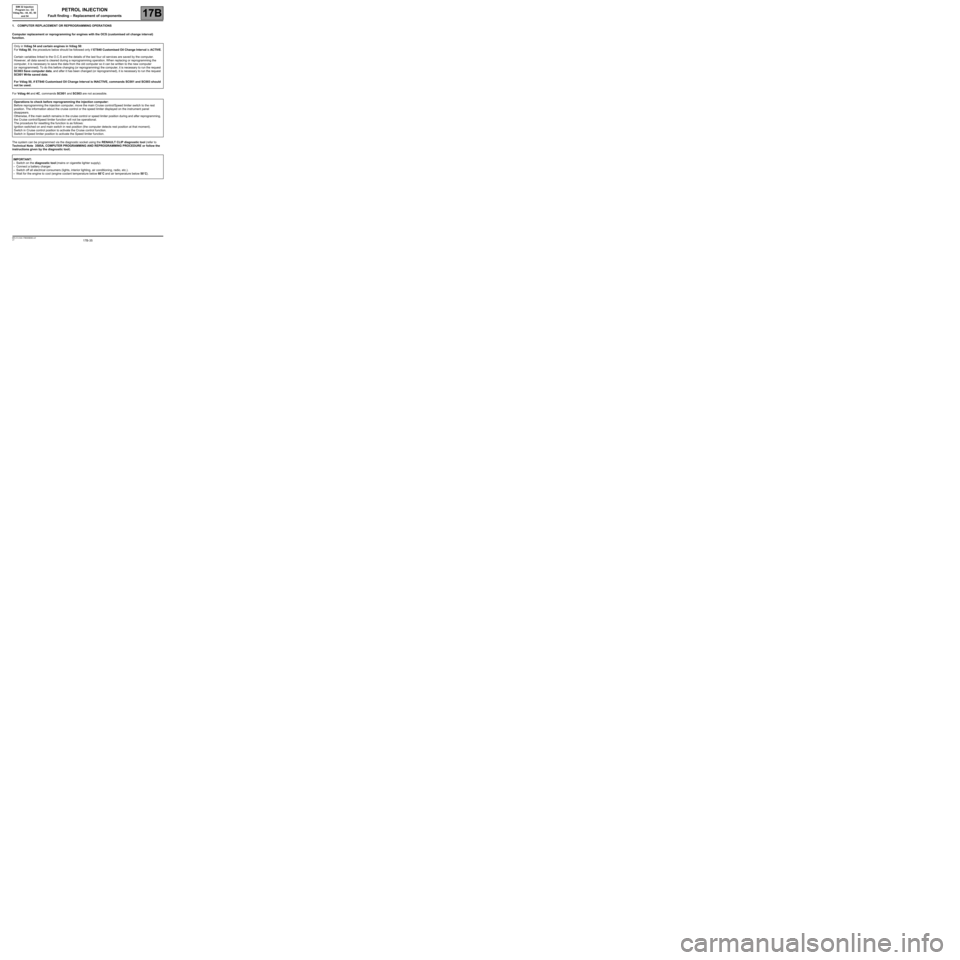
17B-35V7 MR-413-X44-17B000$090.mif
17B
SIM 32 Injection
Program no.: D3
Vdiag No.: 44, 4C, 50
and 54
1. COMPUTER REPLACEMENT OR REPROGRAMMING OPERATIONS
Computer replacement or reprogramming for engines with the OCS (customised oil change interval)
function.
For Vdiag 44 and 4C, commands SC001 and SC003 are not accessible.
The system can be programmed via the diagnostic socket using the RENAULT CLIP diagnostic tool (refer to
Technical Note 3585A, COMPUTER PROGRAMMING AND REPROGRAMMING PROCEDURE or follow the
instructions given by the diagnostic tool). Only in Vdiag 54 and certain engines in Vdiag 50:
For Vdiag 50, the procedure below should be followed only if ET840 Customised Oil Change Interval is ACTIVE.
Certain variables linked to the O.C.S and the details of the last four oil services are saved by the computer.
However, all data saved is cleared during a reprogramming operation. When replacing or reprogramming the
computer, it is necessary to save the data from the old computer so it can be written to the new computer
(or reprogrammed). To do this before changing (or reprogramming) the computer, it is necessary to run the request
SC003 Save computer data, and after it has been changed (or reprogrammed), it is necessary to run the request
SC001 Write saved data.
For Vdiag 50, if ET840 Customised Oil Change Interval is INACTIVE, commands SC001 and SC003 should
not be used.
Operations to check before reprogramming the injection computer:
Before reprogramming the injection computer, move the main Cruise control/Speed limiter switch to the rest
position. The information about the cruise control or the speed limiter displayed on the instrument panel
disappears.
Otherwise, if the main switch remains in the cruise control or speed limiter position during and after reprogramming,
the Cruise control/Speed limiter function will not be operational.
The procedure for resetting the function is as follows:
Ignition switched on and main switch in rest position (the computer detects rest position at that moment).
Switch in Cruise control position to activate the Cruise control function.
Switch in Speed limiter position to activate the Speed limiter function.
IMPORTANT:
–Switch on the diagnostic tool (mains or cigarette lighter supply).
–Connect a battery charger.
–Switch off all electrical consumers (lights, interior lighting, air conditioning, radio, etc.).
–Wait for the engine to cool (engine coolant temperature below 60˚C and air temperature below 50˚C).
PETROL INJECTION
Fault finding – Replacement of components
Page 69 of 348
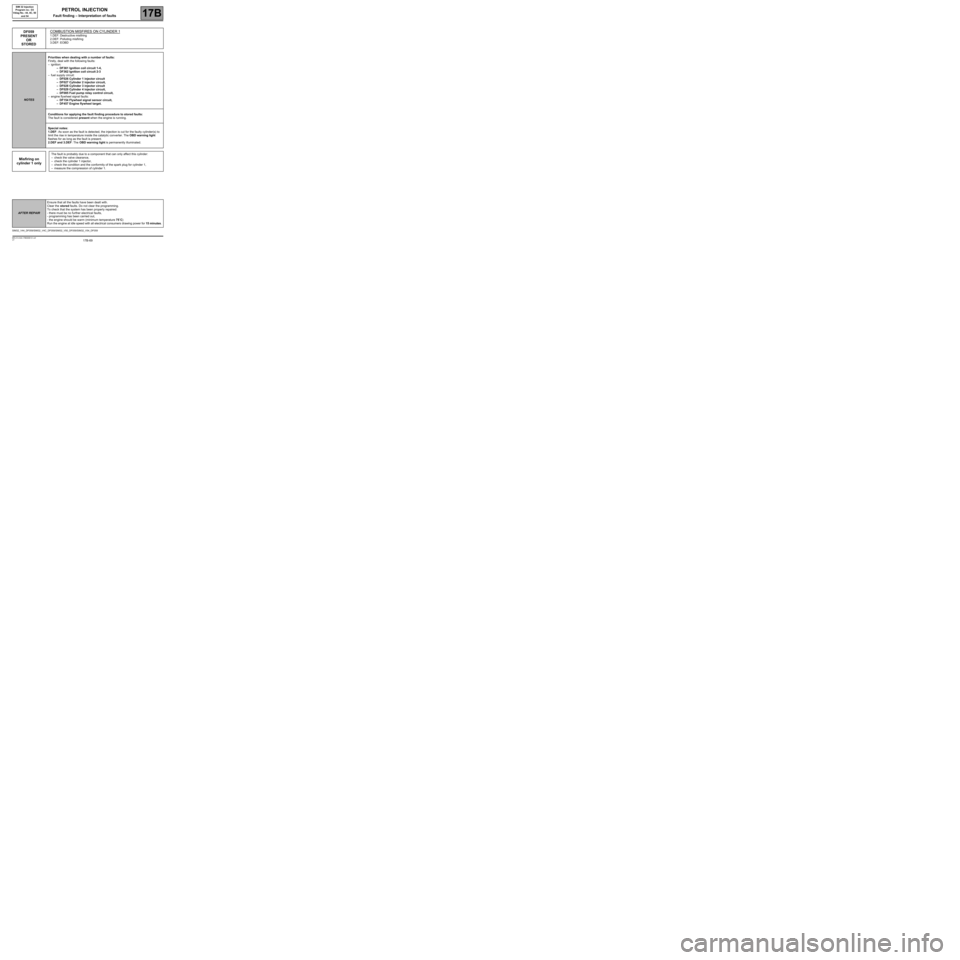
17B-69V7 MR-413-X44-17B000$131.mif
PETROL INJECTION
Fault finding – Interpretation of faults17B
SIM 32 Injection
Program no.: D3
Vdiag No.: 44, 4C, 50
and 54
DF059
PRESENT
OR
STOREDCOMBUSTION MISFIRES ON CYLINDER 1
1.DEF: Destructive misfiring
2.DEF: Polluting misfiring
3.DEF: EOBD
NOTESPriorities when dealing with a number of faults:
Firstly, deal with the following faults:
–ignition:
–DF361 Ignition coil circuit 1-4,
–DF362 Ignition coil circuit 2-3
–fuel supply circuit:
–DF026 Cylinder 1 injector circuit
–DF027 Cylinder 2 injector circuit,
–DF028 Cylinder 3 injector circuit
–DF029 Cylinder 4 injector circuit,
–DF085 Fuel pump relay control circuit,
–engine flywheel signal faults:
–DF154 Flywheel signal sensor circuit,
–DF457 Engine flywheel target.
Conditions for applying the fault finding procedure to stored faults:
The fault is considered present when the engine is running.
Special notes:
1.DEF: As soon as the fault is detected, the injection is cut for the faulty cylinder(s) to
limit the rise in temperature inside the catalytic converter. The OBD warning light
flashes for as long as the fault is present.
2.DEF and 3.DEF: The OBD warning light is permanently illuminated.
Misfiring on
cylinder 1 only
The fault is probably due to a component that can only affect this cylinder:
–check the valve clearance,
–check the cylinder 1 injector,
–check the condition and the conformity of the spark plug for cylinder 1,
–measure the compression of cylinder 1.
SIM32_V44_DF059/SIM32_V4C_DF059/SIM32_V50_DF059/SIM32_V54_DF059
AFTER REPAIREnsure that all the faults have been dealt with.
Clear the stored faults. Do not clear the programming.
To check that the system has been properly repaired:
- there must be no further electrical faults,
- programming has been carried out,
- the engine should be warm (minimum temperature 75˚C)
Run the engine at idle speed with all electrical consumers drawing power for 15 minutes.
Page 70 of 348
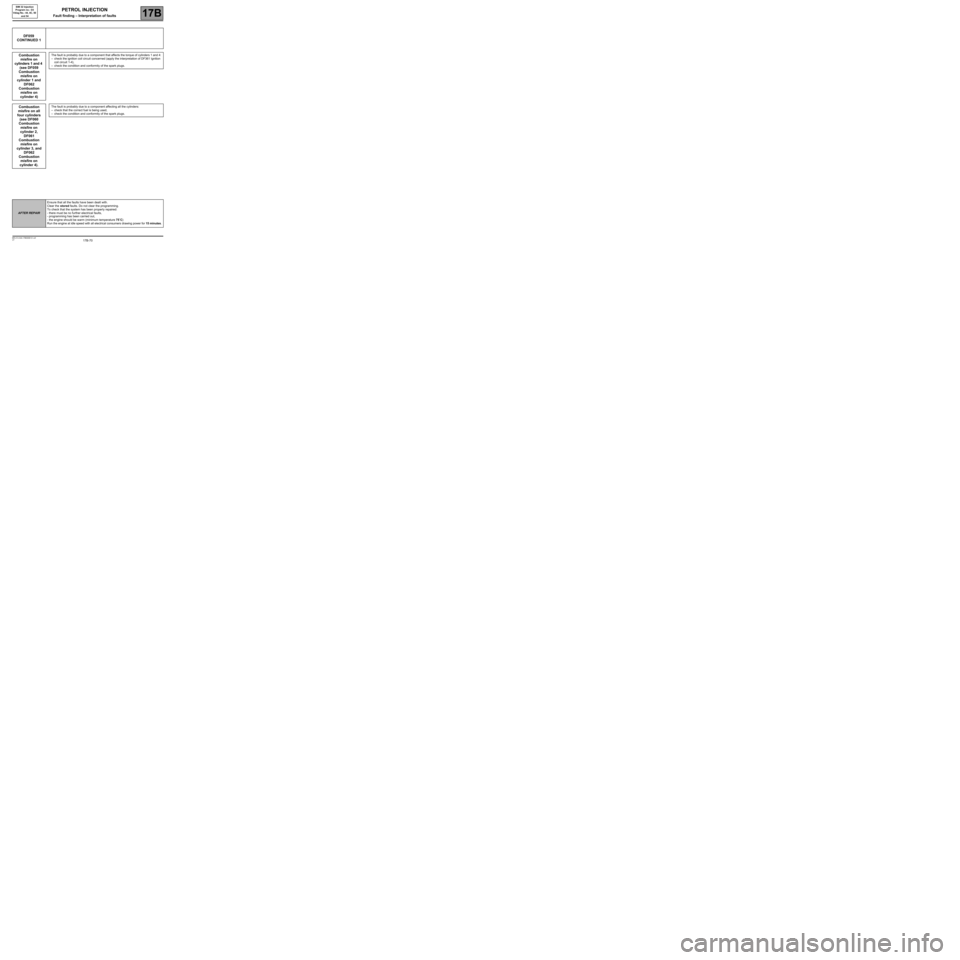
17B-70V7 MR-413-X44-17B000$131.mif
PETROL INJECTION
Fault finding – Interpretation of faults17B
SIM 32 Injection
Program no.: D3
Vdiag No.: 44, 4C, 50
and 54
DF059
CONTINUED 1
Combustion
misfire on
cylinders 1 and 4
(see DF059
Combustion
misfire on
cylinder 1 and
DF062
Combustion
misfire on
cylinder 4)
The fault is probably due to a component that affects the torque of cylinders 1 and 4:
–check the ignition coil circuit concerned (apply the interpretation of DF361 Ignition
coil circuit 1-4),
–check the condition and conformity of the spark plugs.
Combustion
misfire on all
four cylinders
(see DF060
Combustion
misfire on
cylinder 2,
DF061
Combustion
misfire on
cylinder 3, and
DF062
Combustion
misfire on
cylinder 4).The fault is probably due to a component affecting all the cylinders:
–check that the correct fuel is being used,
–check the condition and conformity of the spark plugs.
AFTER REPAIREnsure that all the faults have been dealt with.
Clear the stored faults. Do not clear the programming.
To check that the system has been properly repaired:
- there must be no further electrical faults,
- programming has been carried out,
- the engine should be warm (minimum temperature 75˚C)
Run the engine at idle speed with all electrical consumers drawing power for 15 minutes.